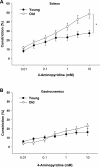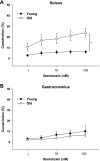Aging and muscle fiber type alter K+ channel contributions to the myogenic response in skeletal muscle arterioles
- PMID: 19407249
- PMCID: PMC2724325
- DOI: 10.1152/japplphysiol.91245.2008
Aging and muscle fiber type alter K+ channel contributions to the myogenic response in skeletal muscle arterioles
Abstract
Aging diminishes myogenic tone in arterioles from skeletal muscle. Recent evidence indicates that both large-conductance Ca2+-activated (BKCa) and voltage-dependent (KV) K+ channels mediate negative feedback control of the myogenic response. Thus we tested the hypothesis that aging increases the contributions of KV and BKCa channels to myogenic regulation of vascular tone. Because myogenic responsiveness differs between oxidative and glycolytic muscles, we predicted that KV and BKCa channel contributions to myogenic responsiveness vary with fiber type. Myogenic responses of first-order arterioles from the gastrocnemius and soleus muscles of 4- and 24-mo-old Fischer 344 rats were evaluated in the presence and absence of 4-aminopyridine (5 mM) or iberiotoxin (30 nM), inhibitors of KV and BKCa, respectively. 4-Aminopyridine enhanced myogenic tone with aging and normalized age-related differences in both muscle types. By contrast, iberiotoxin eliminated age-related differences in soleus arterioles and had no effect in gastrocnemius vessels. KV1.5 is an integral component of KV channels in vascular smooth muscle; therefore, we determined the relative protein expression of KV1.5, as well as BKCa, in soleus and gastrocnemius arterioles. Immunoblot analysis revealed no differences in KV1.5 protein with aging or between variant fiber types, whereas BKCa protein levels declined with age in arterioles from both muscle groups. Collectively, these results suggest that the contribution of BKCa to myogenic regulation of vascular tone changes with age in soleus muscle arterioles, whereas increased KV channel expression and negative feedback regulation of myogenic tone increases with advancing age in arterioles from both oxidative and glycolytic muscles.
Figures







Comment in
-
Setting the "tone" for aging in the skeletal muscle microcirculation.J Appl Physiol (1985). 2009 Aug;107(2):377-8. doi: 10.1152/japplphysiol.00579.2009. Epub 2009 Jun 4. J Appl Physiol (1985). 2009. PMID: 19498095 No abstract available.
Similar articles
-
Effects of aging on the vasoconstrictor reactivity and potassium channel regulation of diaphragm arterioles from male and female Fischer-344 rats.J Appl Physiol (1985). 2025 Jul 1;139(1):275-286. doi: 10.1152/japplphysiol.00152.2025. Epub 2025 Jun 26. J Appl Physiol (1985). 2025. PMID: 40569579
-
Setting the "tone" for aging in the skeletal muscle microcirculation.J Appl Physiol (1985). 2009 Aug;107(2):377-8. doi: 10.1152/japplphysiol.00579.2009. Epub 2009 Jun 4. J Appl Physiol (1985). 2009. PMID: 19498095 No abstract available.
-
Exercise training reverses alterations in Kv and BKCa channel molecular expression in thoracic aorta smooth muscle cells from spontaneously hypertensive rats.J Vasc Res. 2014;51(6):447-57. doi: 10.1159/000369928. Epub 2015 Jan 30. J Vasc Res. 2014. PMID: 25661478
-
Changes in the expression and function of arterial potassium channels during hypertension.Vascul Pharmacol. 2002 Jan;38(1):13-23. doi: 10.1016/s1537-1891(02)00122-2. Vascul Pharmacol. 2002. PMID: 12378818 Review.
-
Ion channels and the regulation of myogenic tone in peripheral arterioles.Curr Top Membr. 2020;85:19-58. doi: 10.1016/bs.ctm.2020.01.002. Epub 2020 Feb 25. Curr Top Membr. 2020. PMID: 32402640 Free PMC article. Review.
Cited by
-
Functional, Structural and Proteomic Effects of Ageing in Resistance Arteries.Int J Mol Sci. 2024 Feb 23;25(5):2601. doi: 10.3390/ijms25052601. Int J Mol Sci. 2024. PMID: 38473847 Free PMC article. Review.
-
Different Effects of Hypertension and Age on the Function of Large Conductance Calcium- and Voltage-Activated Potassium Channels in Human Mesentery Artery Smooth Muscle Cells.J Am Heart Assoc. 2016 Sep 14;5(9):e003913. doi: 10.1161/JAHA.116.003913. J Am Heart Assoc. 2016. PMID: 27628569 Free PMC article.
-
KV channels and the regulation of vascular smooth muscle tone.Microcirculation. 2018 Jan;25(1):10.1111/micc.12421. doi: 10.1111/micc.12421. Microcirculation. 2018. PMID: 28985443 Free PMC article. Review.
-
Depressed perivascular sensory innervation of mouse mesenteric arteries with advanced age.J Physiol. 2016 Apr 15;594(8):2323-38. doi: 10.1113/JP270710. Epub 2015 Jun 30. J Physiol. 2016. PMID: 26010764 Free PMC article.
-
The vascular conducted response in cerebral blood flow regulation.J Cereb Blood Flow Metab. 2013 May;33(5):649-56. doi: 10.1038/jcbfm.2013.25. Epub 2013 Feb 27. J Cereb Blood Flow Metab. 2013. PMID: 23443170 Free PMC article. Review.
References
-
- Ahmed A, Waters CM, Leffler CW, Jaggar JH. Ionic mechanisms mediating the myogenic response in newborn porcine cerebral arteries. Am J Physiol Heart Circ Physiol 287: H2061–H2069, 2004. - PubMed
-
- Amberg GC, Santana LF. Kv2 channels oppose myogenic constriction of rat cerebral arteries. Am J Physiol Cell Physiol 291: C348–C356, 2006. - PubMed
-
- Armstrong RB, Phelps RO. Muscle fiber type composition of the rat hindlimb. Am J Anat 171: 259–272, 1984. - PubMed
-
- Beere PA, Russell SD, Morey MC, Kitzman DW, Higginbotham MB. Aerobic exercise training can reverse age-related peripheral circulatory changes in healthy older men. Circulation 100: 1085–1094, 1999. - PubMed
Publication types
MeSH terms
Substances
Grants and funding
LinkOut - more resources
Full Text Sources
Medical
Miscellaneous

